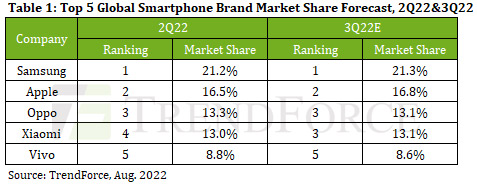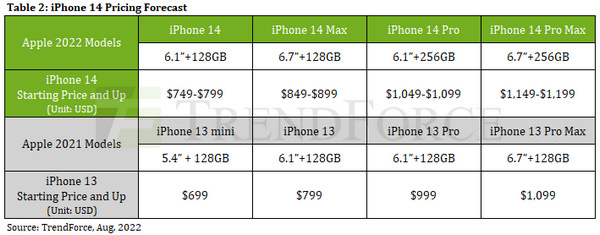News: Markets
1 September 2022
Smartphone production falls 6% in Q2 to 292 million
According to market research firm TrendForce, second-half 2022 smartphone production planning was quite conservative as brands gave priority to adjusting distribution channel inventory. At the same time, weak market demand worsened on the back of China’s pandemic controls and brands were forced to lower their production targets. As a whole, production volume dropped by 6% in second-quarter 2022, even though volume had always grown in previous second quarters. Global output was only about 292 million units, down 5% on the same period in 2021 when a second wave of pandemic outbreaks occurred in South Asia and Southeast Asia.

As the primary vendor in Europe, Samsung was forced to carry out a series of inventory adjustments for finished products and components including large-scale promotions and suspension of component procurement due to the impact of the Russian-Ukrainian war. Thus, production volume in Q2/2022 was significantly reduced by 16.3% quarter-to-quarter to 61.8 million units. Looking to Q3, Samsung is still focusing on the adjustment of distribution channel inventory and, as the outlook remains conservative, total production in Q3 is forecasted to remain flat or trend upward marginally compared with Q2. It is worth noting that, in recent years, due to its aggressive investment in R&D and marketing of folding devices, Samsung has successfully maintained the popularity of these devices, and has also become the market leader in this segment. Samsung will account for nearly 90% of the 1.1% global smartphone market share held by folding devices in 2022.
For Apple, Q2 is a transition period as it hands off old models for new and is nominally the quarter with the lowest production performance during the year. Initial operational performance was affected in Q2 by the implementation of lockdowns in Shanghai and Kunshan which hobbled supply chain supply. The output shortfall created during the lockdown period was made up with production capacity adjustment after the lockdowns were lifted. Apple still produced 48.2 million units in Q2, ranking second in the world. Looking to Q3, the iPhone 14 Pro and Pro Max are among four new models to be upgraded to the A16 (TSMC 4nm) processor. Upgrades such as initial starting memory capacity increasing to LPDDR5 6GB and 256GB, primary camera moving up to 48 million, Face ID Design changes etc., are expected to raise starting prices. However, under pressure from rising global inflation and foreign exchange rates, Apple is expected to adopt a more cautious pricing strategy so as not to affect its sales performance.

OPPO (including Realme, OnePlus) produced 38.8 million units in Q2, down 4.2% quarter-on-quarter. Xiaomi (including Redmi, POCO, Black Shark) produced 38 million units, down 14.6%. Since Vivo (including iQoo) began to adjust its pace of production significantly in Q1/2022, it rebounded by 12.7% to 25.7 million units in Q2. Ranked third to fifth respectively, these three brands overlap significantly in sales market and product planning. In Q2, China’s lockdowns plus extreme weather in the Indian market affected economic performance, resulting in sluggish sales in these two major markets, which in turn affected production performance. Furthermore, the rapid rise of Honor in the Chinese market poses a considerable threat to the market share of brands such as OPPO, Xiaomi and Vivo. Honor’s market share in China is estimated to surpass Xiaomi and approach OPPO and Vivo in 2022.
Looking to Q3, China’s economy (the primary market of OPPO, Xiaomi and Vivo) is expected to remain weak. Originally upbeat emerging markets such as India and Indonesia have also found it difficult to maintain growth due to global inflation, food crises and extreme weather. Considering the numerous negative market factors and the fact that distribution channel inventory is still to be digested, TrendForce believes that the production volume of the three aforementioned brands will be roughly in line with Q2, while all showing a sharp decline of more than 10% compared with the same period last year, which is enough to herald worrying performance in peak season during second-half 2022. On the whole, the Chinese market (one of the world’s three major markets) has reached a high degree of saturation and demand growth has slowed. In the future, the focus of China’s three major smartphone brands will remain on expanding overseas markets, TrendForce concludes.
Smartphone production volume falls 12.8% to 310 million in Q1 due to amplified off-season effect









